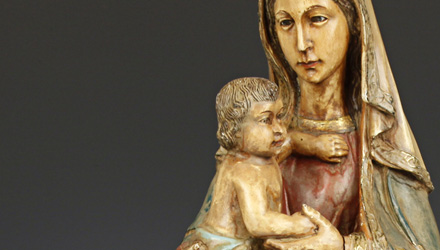Madonna Statue from French Colonial Vietnam
 |
|
Vietnam borders on Cambodia, Laos, and China and stretches for 1600 kilometers down the eastern coast of the Indochinese peninsula. There are many forms of Vietnamese popular art. Among the most notable are traditional paintings on silk, ceramics, lacquered objects, and sculpture pertaining to religious subjects, most notably Buddhism, Taoism, Confucianism and Christianity. These four religions form the basis of the spiritual and religious life of the Vietnamese people. In the past, Buddhism, Taoism and Confucianism mixed together with Chinese customs and various local animistic beliefs to produce what the Vietnamese call “Tam Giao,” or triple religion. Christianity was never the dominant religion of the country, but was tolerated and prospered, primarily among the minority peoples.
 |
|
The Catholic Church reached Vietnam in the 16th century, when it was brought there by missionaries from France, Spain and Portugal. The history of Catholicism in Vietnam is a story of perseverance. In 1630 Christianity was prohibited and in 1663 persecutions began. The church resurrected itself and more persecutions took place a hundred years later, in 1773. By the 1820s, the church once again established itself as a coherent, cohesive religion in the area. Persecutions then took place under the rule of Emperor Minh Hang, known as “the Nero of Indochina.” The ebb and flow of Christian thought and practice continued through the establishment of Vietnam as French Indochina in 1887. It continues right to the present day. When the country was unified under the communist regime in 1975, seminaries and schools were closed and civil authorities began to interfere with church business. However, in subsequent decades there has been a loosening of civil interference and today, it is agreed that Catholicism is once again re-establishing itself.
Today, there are nearly 6 million practicing Catholics in Vietnam. Many parishes in Catholic regions have been reinvigorated and refinanced, and in turn, have sought to upgrade their French Colonial-era churches. The romantically naturalistic, European-inspired style of architectural and decorative elements in the old churches is no longer expressive of the 21st century trajectory of the Catholic Church.
In the 1990s, the Vietnamese State Committee of Religious Affairs began to allow the construction of new churches and that inevitably meant some of the older structures and their accoutrements would be de-consecrated and sold to assist with the building of new churches. It is in this context that the Mary & Jesus altar figure was acquired. It dates from the 19th century and comes from the northern part of Vietnam. In this particular piece, the graceful sway or leaning attitude of the Madonna is accentuated by her richly carved and musically flowing robe.

|
|
| |
|
Download this Article: Madonna Statue, French Colonial Vietnam.pdf